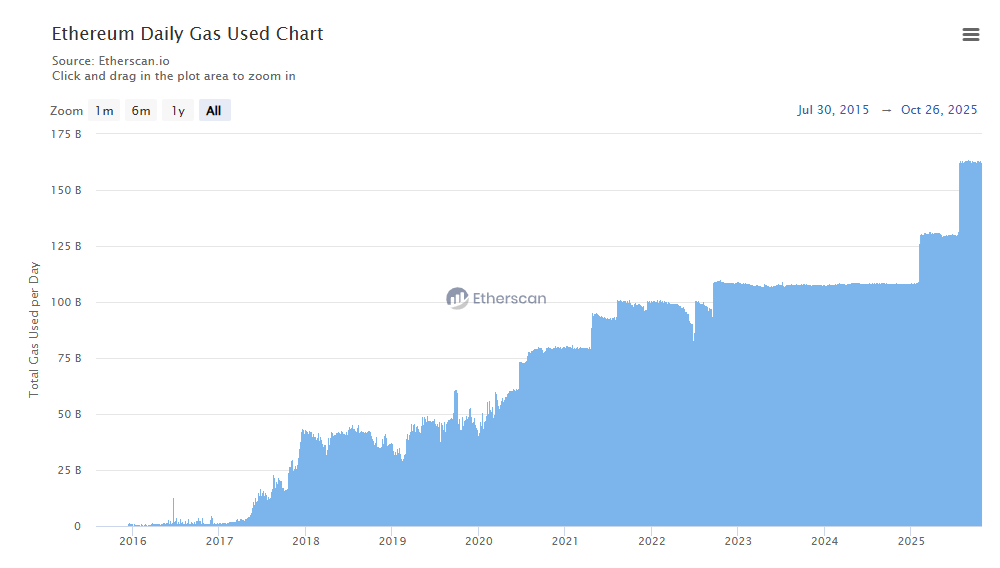Ethereum’s on-chain activity has surged to a five-month peak, driven by heightened DeFi interactions, smart contract deployments, and stablecoin transfers. This increase in gas usage reflects growing network engagement, with daily active addresses reaching around 550,000 and ETH transactions outpacing USDC volumes recently, signaling robust ecosystem health.
-
Ethereum gas usage hits five-month high amid DeFi and stablecoin boom.
-
Smart contract activity and DEX trading fuel the surge in network transactions.
-
Daily active addresses climb to 550K, with 48 ETH burned daily from DeFi apps, per Etherscan metrics.
Ethereum on-chain activity surges to five-month peak: Explore DeFi growth, stablecoin trends, and ETH price recovery above $4,000. Stay ahead in crypto—read insights now. (142 characters)
What is driving Ethereum’s on-chain activity surge to a five-month peak?
Ethereum’s on-chain activity surge stems primarily from increased DeFi interactions, smart contract executions, and stablecoin transfers, pushing gas usage to levels not seen in five months. This revival highlights the network’s resilience post-market volatility, with Layer 1 engagement rising while Layer 2 solutions handle scaling efficiently. Daily gas consumption has stabilized at elevated levels, underscoring sustained user interest.
 ETH gas usage surged to new records, boosted by DeFi, stablecoin usage, and new smart contracts. | Source: Etherscan
ETH gas usage surged to new records, boosted by DeFi, stablecoin usage, and new smart contracts. | Source: EtherscanEthereum’s network has long been the backbone of decentralized finance, and recent data from blockchain analytics platforms like Etherscan reveals a marked uptick in activity. Gas usage, a key indicator of network demand, reached a five-month peak, reflecting broader adoption trends. This isn’t isolated; it’s part of a pattern where Ethereum’s core Layer 1 chain sees renewed vigor, even as Layer 2 rollups manage a significant portion of transactions.
The surge aligns with macroeconomic shifts in the crypto space, where investors seek reliable platforms amid uncertainty. Ethereum’s proof-of-stake mechanism, implemented via the Merge upgrade, has optimized energy efficiency, making it more attractive for high-volume applications. Experts note that this activity spike correlates with historical bull phases, potentially foreshadowing price appreciation for ETH.
How are stablecoins and DeFi contributing to Ethereum’s gas usage increase?
Stablecoins like Tether (USDT) and USD Coin (USDC) dominate Ethereum’s smart contract interactions, accounting for a substantial share of gas expenditure. Tether leads as the most active contract, followed closely by Circle’s USDC, with transfers and swaps driving consistent network load. DeFi protocols, the primary gas consumers, burn approximately 48 ETH daily through transaction fees, according to ultrasound.money data, which tracks Ethereum’s deflationary mechanics.
This activity is bolstered by low gas prices, currently under one gwei on the mainnet, thanks to Layer 2 scaling solutions that reduce costs for users. DEX trading volumes have rebounded, with swaps averaging $0.21 in fees, encouraging more participation. Routers and aggregators, essential for efficient trading, further amplify demand, while perpetual futures platforms see heightened usage.
Phishing-related smart contracts have unfortunately infiltrated the top gas burners, highlighting ongoing security challenges. However, legitimate incentives, such as NFT minting for gas user identities, add to the mix. Lending protocols like Aave hold over $32 billion in total value locked (TVL), part of Ethereum’s $89 billion ecosystem TVL, per DeFiLlama reports. Liquidatable positions in these protocols have doubled to $2.2 billion, with loans concentrated around $3,600 ETH levels, indicating rising risk appetite post the October 10-11 crash.
Layer 2 networks, while slowing in raw activity, capture over 15% of Ethereum’s economic output in revenues, per Grow The Pie analytics. This division ensures liquidity remains on Layer 1, fostering a balanced ecosystem. Ethereum’s daily active addresses have climbed to about 550,000, a baseline increase from prior months, suggesting organic growth rather than speculative spikes.
From a technical standpoint, the EIP-1559 fee mechanism continues to burn base fees, enhancing ETH’s scarcity. Analysts from Glassnode observe that ETH transfers recently surpassed USDC in volume, a reversal from earlier trends, pointing to native token utility resurgence. This multifaceted activity underscores Ethereum’s maturity as a settlement layer for global finance.
Frequently Asked Questions
What factors are behind the recent peak in Ethereum’s on-chain metrics?
The peak in Ethereum’s on-chain metrics results from amplified DeFi usage, stablecoin movements, and smart contract deployments, leading to higher gas consumption. Low fees via Layer 2s have lowered barriers, while TVL in protocols like Aave exceeds $32 billion, drawing more users to the network for lending and trading opportunities.
Is Ethereum’s gas usage surge a sign of a bull market recovery?
Ethereum’s gas usage surge indicates recovering network health, often aligning with bull market phases where active addresses and transactions rise. With daily addresses at 550,000 and ETH burning 48 units daily from DeFi, it suggests sustained demand, though market conditions remain volatile for short-term traders.
Key Takeaways
- DeFi and stablecoins lead activity: They account for the bulk of gas usage, with Tether and USDC topping smart contracts and burning 48 ETH daily through fees.
- Layer 1 resilience amid Layer 2 growth: L1 handles primary liquidity, while L2s contribute 15% of revenues, balancing scalability and core network strength.
- Price recovery signals optimism: ETH above $4,000 reflects ecosystem demand; monitor lending risks as liquidations hit $2.2 billion for potential volatility.
Conclusion
Ethereum’s on-chain activity surge to a five-month peak, fueled by DeFi expansion and stablecoin dominance, positions the network for continued relevance in decentralized ecosystems. With gas usage elevated and active addresses at 550,000, the platform demonstrates robust recovery from recent market turbulence. As TVL surpasses $89 billion, investors should watch for breakout potential in ETH pricing—consider integrating Ethereum-based strategies to capitalize on this momentum.
